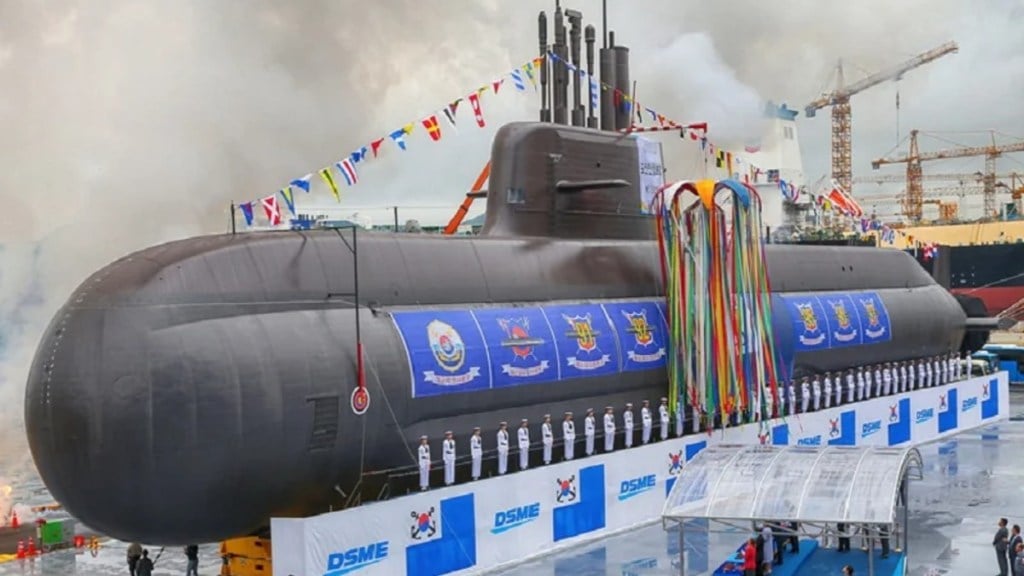The long delayed Project 75 (I) is back on track. There are two companies: South Korean company Daewoo Shipbuilding & Marine Engineering which has offered its KSS-3 submarine and the German company ThyssenKrupp Marine Systems (TKMS) has pitched its Type 218 (Invincible Class). Both these companies are in race for bagging the Indian Navy’s six advanced conventional submarines under Project-75 (I).
The other companies which were in race and have withdrawn from the race include: the Naval Group of France which was involved in the `Scorpene’ class submarine for the Indian Navy under Project-75; Rosoboronexport of Russia for the Amur and Navantia of Spain offered S-80 (Issac Peral class).
Financial Express Online has reported earlier that the Project 75(I) is the second project to be processed under the Strategic Partnership Model (SP). Through transfer of technology the submarines will be built in India wherein the Original Equipment Manufacturer (OEM) on winning the bid will have to tie up with an Indian company for manufacturing/building the boats in India under Indian government’s `Make in India’ initiative. The process started back in 2017 when the Ministry of Defence had sent out Request for Information to the global companies.
Both the KSS-3 and Type 218 Invincible Class submarines possess advanced features and capabilities suitable for modern naval operations.
More about the South Korean KSS-3 (III) submarine and the German Type 218 Invincible Class submarine:
Design and Capabilities:
The KSS-3, also known as the Dosan Ahn Changho-class submarine, is a diesel-electric attack submarine developed by South Korea. It is a next-generation submarine with advanced technology and enhanced stealth features. The KSS-3 incorporates German technology and is designed to operate effectively in littoral and open ocean environments.
The Type 218 Invincible Class submarine, developed by Germany, is a modern diesel-electric submarine. It features stealth characteristics and advanced technology for improved performance. The Type 218 submarines are known for their versatility and are capable of various missions, including anti-submarine warfare, intelligence gathering, and special operations support.
Size and Displacement:
The KSS-3 submarine has an approximate length of 83 meters and a displacement of around 3,000 tons. It is a large submarine that offers ample space for crew and equipment, allowing for extended missions.
The Type 218 submarines have a length of approximately 90 meters and a displacement of around 2,450 tons. They are relatively larger than the KSS-3 submarines, providing increased capacity for various payloads and operations.
Propulsion and Endurance:
The KSS-3 submarines utilize a conventional diesel-electric propulsion system. It can be equipped with an air-independent propulsion (AIP) system, like the one used in the Son Won II-class submarines, which enables longer underwater endurance without surfacing.
The Type 218 submarines also employ a diesel-electric propulsion system. They are equipped with a state-of-the-art air-independent propulsion (AIP) system that allows for extended underwater operations, enhancing their endurance and stealth capabilities.
Armament and Systems:
The KSS-3 submarines are equipped with a range of weapons and systems, including torpedoes, anti-ship missiles, and surface-to-air missiles. They feature advanced sensor and communication systems for effective surveillance and combat capabilities.
The Type 218 submarines are armed with heavyweight torpedoes, anti-ship missiles, and cruise missiles for various mission requirements. They also feature advanced sonar and sensor suites, providing excellent situational awareness.
Export and International Cooperation:
South Korea has offered the KSS-3 submarines for India’s Project 75I, indicating its potential for international cooperation and export. South Korea has gained expertise in submarine construction through collaboration with Germany, as seen in the integration of German technology in the KSS-3 submarines.
The German Type 218 submarines have also been offered for international projects and collaborations. Germany has a long-standing reputation as a reliable submarine manufacturer, with its submarines being operated by various navies around the world.
More about South Korean Navy’s Submarines:
Jang Bogo-class submarines are built upon the renowned German Type 209 design, while the Son Won II-class submarines integrate an advanced air-independent-propulsion system developed by Germany. Moreover, South Korea has successfully licensed and built Type 214 submarines from Germany, which has played a crucial role in establishing South Korea as a prominent submarine builder in its own right.
The Jang Bogo-class submarines utilize German-made diesel engines, electric motors, and sonar systems, showcasing the high-quality German engineering incorporated into these vessels.
The Son Won II-class submarines employ a German-developed air-independent propulsion (AIP) system, allowing them to operate underwater for extended periods without refueling, enhancing their endurance and stealth capabilities.
The South Korean Navy’s new KSS-III submarine class also draws from German technology, featuring cutting-edge weapons and sensors, including German-manufactured torpedoes and surface-to-air missiles.
South Korea has acquired various German-made missiles for its submarines, including the DM2A4 torpedo, the UGM-84 Harpoon anti-ship missile, and the IDAS anti-submarine missile.
The DM2A4 torpedo is a heavyweight wire-guided weapon used for anti-submarine and anti-surface warfare, with a remarkable range exceeding 50 kilometers and speeds of up to 50 knots.
The UGM-84 Harpoon is an anti-ship missile launched from submarines, surface ships, and aircraft. It boasts a range surpassing 120 kilometers and can achieve speeds of up to Mach 0.9.
The IDAS serves as an anti-submarine missile launched exclusively from submarines, capable of traveling over 20 kilometers at speeds up to Mach 0.8.
These missiles provide South Korea with a formidable deterrent against potential adversaries and enable the projection of power throughout the region to safeguard its maritime interests.
Furthermore, South Korea is actively developing its indigenous submarine-launched missiles. The inaugural model, the K-Subroc, is anticipated to enter service in the early 2020s. The K-Subroc is a long-range, heavyweight torpedo designed to neutralize enemy submarines at distances up to 100 kilometers.
The acquisition of German-made missiles, coupled with the development of indigenous submarine-launched missiles, stands as a crucial component of South Korea’s ongoing submarine fleet modernization efforts. These endeavors are aimed at ensuring the continued capability of South Korea’s submarines to deter and overcome potential adversaries.

